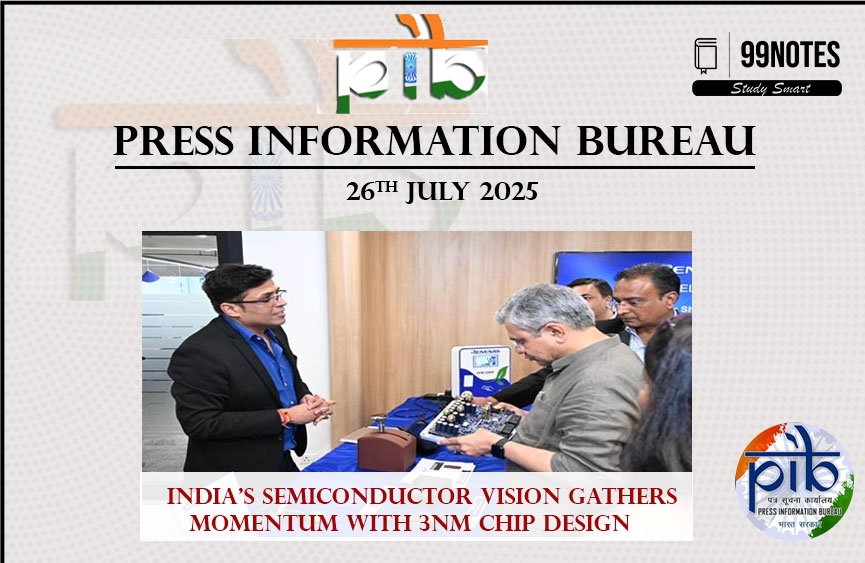26 July 2025: PIB Summary For UPSC
1. India’s Semiconductor Vision Gathers Momentum with 3nm Chip Design and Large‑Scale Talent Development Initiatives
Source – Press Information Bureau (PIB) – Ministry of Jal Shakti (26 July 2025)
|
Topic: GS 3: Indian Economy — Infrastructure & Industrial Development, Technology, Government Initiatives |
|
Context |
|
Content:
Overview
-
India is home to nearly 20% of global chip‑design engineers. A 3 nm semiconductor chip designed in India was recently unveiled, demonstrating technical prowess and global competitiveness.
-
The Government is promoting in‑country chip design, R&D, manufacturing, and talent development, positioning India as a trusted global semiconductor partner.
Key Initiatives & Measures
1. Talent Development & Curriculum Reform
-
AICTE‑approved curriculum on VLSI Design & Technology and IC manufacturing introduced.
-
Target: Develop 85,000 skilled professionals in semiconductor design, with 45,000+ students enrolled across more than 100 institutions.
-
SMART Labs at NIELIT Calicut: training centre aiming to educate up to 1 lakh engineers nationwide; 44,000+ trained already.
-
Collaborations with global academic and industry partners such as Lam Research, IBM, Purdue University to strengthen design capabilities.
2. Semicon India Programme
-
Approved ₹76,000 crore package to build semiconductor and display manufacturing ecosystem.
-
6 manufacturing projects and 22 design‑linked incentive (DLI) schemes approved under the programme.
-
Infrastructure support: Provision of EDA tools, FPGA boards from Synopsys, Cadence, Siemens, etc., and access to Post‑Silicon validation, testing and packaging resources.
Analysis & Significance
-
Leverage domestic talent: With India accounting for a significant share of the design workforce, these measures convert human capital into strategic strength.
-
Moving up value chain: Shifting from software to hardware (chip‑design & fabrication) enhances technological autonomy and reduces dependency.
-
Employment generation: A large skilled workforce, allied with manufacturing build‑out, will spur high‑value job creation.
-
Global positioning: End‑to‑end capacity (design–manufacture–packaging) makes India a credible global partner in semiconductor supply chains.
-
Strategic imperatives: Semiconductor capability aligns with national security, digital infrastructure, Make in India, and critical technologies (e.g. AI, 5G).
Conclusion
-
Continued scaling of institutions and enrolment to meet the 85,000+ design talent target.
-
Fast‑track approvals, land, capital and infrastructure support under Semicon India Programme; ensure timely commissioning of projects.
-
Strengthen industry–academia collaboration, including more MOUs, joint research projects, incubation cells.
-
Encourage startups and MSMEs in EDA tool development, chip prototyping, packaging services.
-
Focus on integrated chip manufacturing, packaging and testing facilities within India to enhance value retention and sovereign capability.
|
Practice Question: “India is home to nearly 20% of the world’s chip design engineers, yet the nation lacks full chip‑manufacturing capability. Critically examine how the Government’s Semicon India Programme and talent‑development initiatives can transform India into a global semiconductor hub. What are the major challenges and how should they be mitigated?” |
Check this out 25 July 2025: PIB Summary For UPSC

